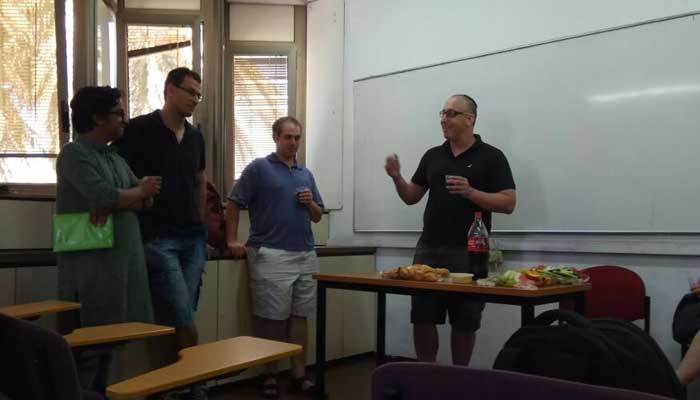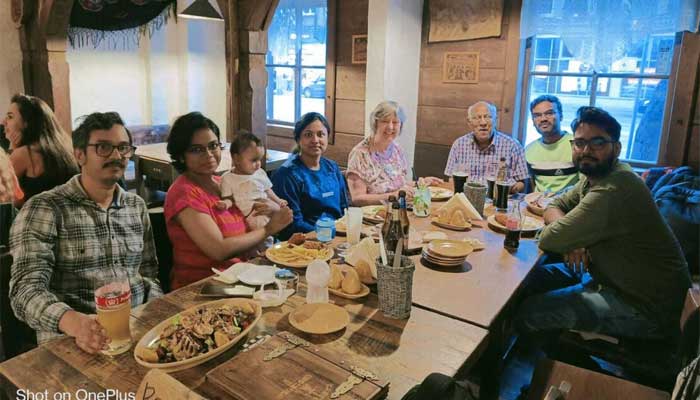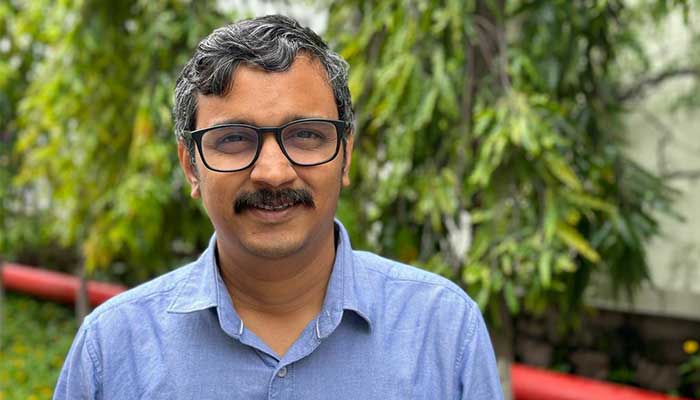Dr. Chittaranjan Hens’s work on network sciences at IIIT Hyderabad bridges applied mathematics and statistical physics, to capture the emerging behavior in epileptic brain dynamics and the spreading pattern of epidemics like Covid 19. We learn more.
Dr. Chittaranjan’s life is anything but mainstream. Physics has taken the scientist to many beautiful places around the globe; from his remote village Badanganj to Bonn, Dusseldorf, Dresden, Trieste, Israel, Poland and beyond. The raging Covid pandemic and the beginning of the Ukraine invasion placed him in the epicenter of chaos, with each experience bringing new learnings and valuable insights. He joined IIITH’s Center for Computational Natural Sciences and Bioinformatics (CCNSB) as an Assistant Professor – Inspire in mid-2022. Earlier this year, he would become the first IIITH faculty to co-author a publication in the prestigious Nature Physics.
Early education, Sabbath and more at Bar Ilan University,
Israel
“Statistical physics, nonlinear dynamics and network science are my primary study interests”, he explains. “My investigation focuses on functional networks derived from epileptic data and the propagation of disease in complex networks”.
Chittaranjan completed his B.Sc and Masters from Jadavpur University (2003-08). While pursuing his Ph.D in Physics from Kolkata’s CSIR – Indian Institute of Chemical Biology (2008-15), he worked on the chaos theory under eminent professors like Syamal Kumar Dana and Ulrike Feudel from the University of Oldenburg, Germany. His thesis was related to nonlinear dynamics and complex networks and how it emerges in a dynamical system. For instance, to predict the weather for the next fortnight, problems intrinsic to how nature works, is analyzed and computed. As a PBC-postdoctoral fellow at Bar Ilan University Israel (2015 – 18), Chittaranjan worked at the Department of Mathematics with statistical physicist Baruch Barzel from the network science community, who specialized in applied mathematics.




Living close to a synagogue, Chittaranjan and his wife Ankita experienced the rigid purity of their Sabbath when everything shut down on the holy day. “However, their food was interesting and we enjoyed the shawarma, falafel and shakshuka”.
Network sciences for the layman
Chittaranjan explains that network science analyzes a phenomenon using tools such as statistical physics, linear algebra and graph theory. Whether it is to understand the spread of an epidemic like Covid-19 via airports and flight schedules or the viral trajectory of a malicious rumour, what you need is proper mapping and dynamical mechanism to understand the spread of the disease or rumour.
“Using the same mechanism, we sought to understand in theory if we can apply it to an ecological system. Ecology comprises of a multitude of species that interact with each other, but still maintain a bio-stable biodiversity. To a stable biodiversity, if a disease impacts a particular species, we try to understand whether the disturbance to that one species would affect other species and the timeline for mutation and repair”, explains Chittaranjan who published a paper in Nature Physics (Spatiotemporal signal propagation in complex networks) in 2019.
“Further, we provide the framework and tools for epidemiologists, mathematicians or statistical physicists to use the data and provide insights to the government on disease control”, he elaborates. “For instance, for the municipal wards in Kolkata, hypothetical projections were given for stocking of Covid 19 test kits, after reviewing the realistic connectivity pattern on the disease progression”. They also analyzed district-wise Covid data (India), and impact of variants to identify hotspots using tools from signal processing, statistical physics and network science and scrutinised large gatherings in Kerala and the Maha Kumbh Mela to understand if they had contributed to super spreading events.
Train rides to Bonn and the Ukraine war effect
“In the case of epileptic seizures, from the complex network of billions of neurons that make up the brain, we investigate the neural network to find out which neurons are malfunctioning, to be rectified with medical intervention”. Prior to joining IIITH, as a DST-INSPIRE faculty at the Indian Statistical Institute in Kolkata, Chittaranjan had an interesting tenure at the Department of Epileptology, Bonn University. The researcher collaborated with Professor Klaus Lehnertz, a physicist at Bonn University Hospital (Dept. of Epileptology), who has been working with data on epileptic patients to understand how epileptic seizures progress in the brain after onset.
From May 2021 (until May 2022), Chittaranjan joined his wife Ankita at Dusseldorf, where she was pursuing her postdoc in electrochemistry on a prestigious AVH fellowship. It was a daily 60km train ride to his University at Bonn. It was around the same time that the Russian invasion of Ukraine had begun, while Covid-19 continued to rage, and for the first time, he saw the German train schedules, renowned for punctuality go awry. “Fortunately, the Germans were very considerate and didn’t give me grief for being late to work, thanks to their diversity training from school up, I suppose”, he grins.
Confluence of research at IIITH
“IIIT Hyderabad was already something I knew about”, notes the scholar. “My friends claimed that this area is akin to heaven for techies and information technologists. I was astonished when I took a quick look at the profiles of other academics while applying for a faculty position. I realised that this institute isn’t just for techies; it also brings together linguists, social scientists, and theoretical scientists. I figured that perhaps this could be the best location for my transdisciplinary research to flourish”.
“Though quantum information is not my cup of tea, I enjoy collaborating with Subhadip Mitra and Indranil Chakrabarty from quantum information, helping their research with our network tools. I am also collaborating with Santosh Nannuru from SPCRC and Nita Parekh from CCNSB on disease propagation in networks. I have two strong collaborations with applied mathematician Dibakar Ghosh at ISI-Kolkata and Pinaki Pal from NIT Durgapur. I continue to work with my PhD supervisors Syamal Dana, Ulrike Feudel, and postdoc supervisor Baruch Barzel. I have keen collaborations with Prof. Stefano Boccaletti from CNR- Institute for Complex Systems, Italy, Prof. Tomasz Kapitanniak, Lodz University, Poland, Prof. Peng Ji from Fudan University, China, Dr. Chandrakala Meena from IISER TVM, India, and Dr. Sirshendu Bhattacharyya from West Bengal”.
Along with his regular course work, the researcher has designed an advanced course in network sciences. In April 2023, he co-authored a publication in Nature Physics (Emergent stability in complex network dynamics), a multinational project with peers from India, Israel and Italy, who set out to provide a mathematical perspective on a 40-year-old query by Prof. Robert May, on the conditions required for a large ecological system to maintain biodiversity .
In continuation of his research (on epileptic seizure) via the DST DAAD travel grant, Chittaranjan and his team will be part of a reciprocal two-year arrangement with Bonn University.
Badanganj’s finest and his favourite IIIT experiences
“It’s been a long journey”, smiles Chittaranjan Hens. “My ancestors were professional Tanti weavers from West Bengal”. He completed his high school from Arambagh, one of the best schools in the subdivision. His most valuable contribution is bringing Badanganj to the world. Coming from a pure rural background gave him a deeper understanding of where nature fits in with our understanding of network science and finding connections between society and science in a heterogeneous structure.
Transitioning from Bengali to English medium was slightly rough for the youngster “but after the first year in college, everything began to work out well. Chittaranjan has published over 60 papers, some in eminent peer-reviewed papers in Nature Physics, Physical Review E, Nature Scientific Reports, Royal Society Interface, etc that have received a lot of positive feedback and inspired additional research. His most memorable conferences were Complex Dynamics in Large-Scale Interacting Brain Systems held at Max Planck Institute for the Physics of Complex Systems, Dresden, Germany in 2009 and the ICTP (International Center for Theoretical Physics) hands-on complex system school-2013 in Trieste near Venice.
Returning from the healthier European work ethic with its regulated work hours and weekends was an adjustment but Chittaranjan now cherishes the serenity of living in IIIT Hyderabad’s verdant campus with Ankita and their toddler Bedangi. “I love the greenery and the tree-lined avenues with its peacocks and snakes”, he says tongue-in cheek. “In my free time, I enjoy listening to Western classical and Indian instrumental music, and watch classical movies whether Bengali or western, that revolve around a musical theme. I prefer historical books, fiction and classics from around the world. As a family, we travel to simple destinations or local historical sites”.
A Diversity workshop conducted by Radhika Krishnan, Indranil Chakrabarty and Shantanav Chakraborty from CQST was a significant IIITH memory that stands out for Chittaranjan. “The interactions with students was really illuminating and the cultural event cast a powerful spotlight on society’s underlying gender discrimination and toxic behavior patterns, using pop culture references from movies and famous film songs”.
Drawing from this memory, his advice to young scientists is this; “Along with classical education in technology and the sciences, learn about your society and the types of economic, caste and gender discrimination that enmesh it. It is important that you translate your education to find deep solutions for societal ills. Develop a scientific attitude and the purity of scientific temper and learn how to maintain it”.
Deepa Shailendra is a freelance writer for interior design publications; an irreverent blogger, consultant editor and author of two coffee table books. A social entrepreneur who believes that we are the harbingers of the transformation and can bring the change to better our world.

